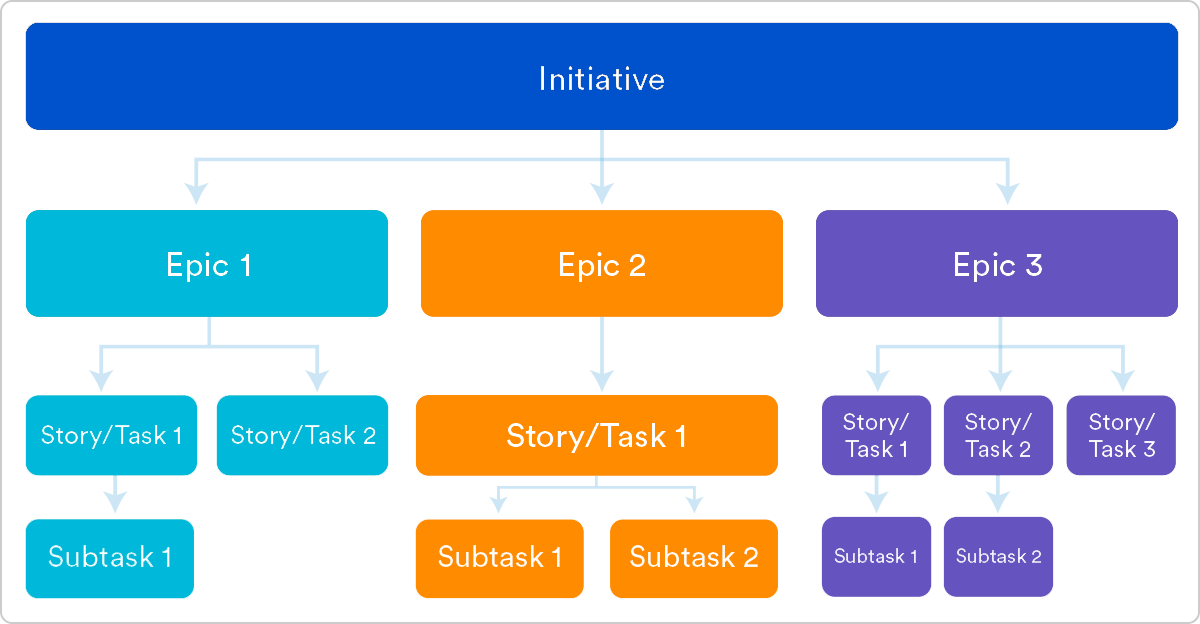Agile Estimation
Agile estimation is a method of estimating the effort required to complete a user story. Agile estimation techniques are typically based on relative estimation, rather than trying to estimate the exact number of hours or days that a task will take.

A step-by-step guide to planning and estimating work: epics, stories, tickets, tasks
Estimating work is both a science and an art in agile software development. Getting it right takes experience, intuition, and the ability to break down work into manageable pieces. In this article, we provide a step-by-step guide to help you hone your estimation skills and set realistic timelines that keep projects on track.
We'll cover techniques for estimating at multiple levels, from high-level epics down to granular tasks. You'll learn when to estimate relative to story points versus hours, how to factor in uncertainty, and how to avoid common pitfalls like anchoring and padding.
With the right approach, you can improve the accuracy of your team's estimates over time. The reward is greater predictability, productivity, and client satisfaction.
Read on to level up your agile estimation expertise.
Estimate and promises
When estimating work, it is important to keep in mind that estimates are just that – estimates. They are not promises, and they should not be treated as such. The goal of estimation is to give the product owner and stakeholders a general idea of how much work is involved in a particular piece of functionality, so that they can make informed decisions about what to include in a release.
Is agile estimation a science?
Estimating work effort is one of the most challenging aspects of software development. Traditional waterfall methods often rely on detailed upfront estimating to create long-term plans and schedules. But agile approaches recognize the difficulty of accurate estimating, especially for complex and novel work. So is there still a science to agile estimation?
While agile estimation is not an exact science, it does rely on some fundamental principles and practices. The goal is to gain enough insight to prioritize work, without getting bogged down in pretensions of precision. Techniques like planning poker use relative sizing to bypass endless debates over days and hours. There are also strategies to break down epics, leverage historical data, and adjust based on new learnings.
The art is in finding the right balance and cadence of estimating for your team and project. Don't assume agile estimation is easy or haphazard. But also recognize that it requires a different mindset than traditional approaches. Embrace techniques that are lightweight yet structured, progressive yet adaptive. With the right framework, agile estimation can yield just enough insight to inform planning and decision-making as work progresses.
Let’s look at the some “agile basics”
What is a scrum team?
Agile is founded on small, self-organizing teams. But what exactly does that mean? To understand the agile approach, you have to start with the scrum team.
The scrum team is the engine that drives agile development. Unlike traditional teams, scrum teams are cross-functional, self-managing, and focused on iterative delivery. They organize around specific roles and ceremonies that enable productivity, adaptability, and accountability.
At the core of a scrum team are the developers, who build the product increment by increment. The product owner represents the customer and prioritizes features and functionality. The scrum master facilitates the team's operations and removes obstacles.
Together, these roles form a tight-knit unit that swarms on work for regular sprints. They hold stand-ups to coordinate and demonstrate working software at the end of each sprint through a review. Retrospectives help identify improvements going forward.
Understanding the scrum team is key to leveraging the power of agile. A high-functioning scrum team can deliver remarkable productivity and innovation. Get the team right, and agile works.
What is sprint planning?
Every agile sprint kicks off with a sprint planning session. This meeting sets the stage for the focused work that follows. So what exactly happens during sprint planning?
Sprint planning brings together the scrum team to select and prepare upcoming work items from the product backlog. The product owner describes the highest priority features to the team. Through discussion, developers estimate the effort involved in delivering each item so the right amount of work can be committed to.
By the end of planning, the team has a sprint goal and sprint backlog defined. This lays out the objectives and tasks to keep the team marching in step for the sprint. It also gets buy-in across the scrum team on what they forecast to accomplish.
Done right, sprint planning sets the sprint up for success. It brings shared understanding of the "why" and "what" of the sprint. It also fosters collaboration between the product owner and developers on shaping the work. Sprinting starts with planning, so don't shortchange this vital ritual.
What is a product backlog?
The product backlog is the single source of truth for what needs built in an agile project. It contains user stories, features, and requirements prioritized by business value. But what keeps the backlog from turning into just another to-do list?
The product owner owns the backlog, constantly grooming and re-ordering its contents. They ensure alignment with the product vision and what will deliver the most value to users and the business. The backlog evolves as the product and market do.
The development team pulls work from the backlog for each sprint. Higher priority items bubble up to the top. The backlog is also where new ideas and change requests funnel into the agile process.
With constant input from stakeholders, the backlog grows and adapts. By keeping it pruned and prioritized, the product owner makes sure the most important work gets done first. This real-time priority queue is what keeps agile teams focused on delivering value, sprint after sprint.
What is a user story?
User stories are the currency of agile development. They capture desired functionality in a simple, conversational format. But what exactly makes an effective user story?
User stories follow a structured template - "As a , I want so that ." This framework pushes the author to think from the user's perspective and articulate the why behind each feature.
Good user stories are concise, yet carry important details through acceptance criteria and story points for estimation. Epics group related stories to capture larger initiatives.
Writing compelling user stories takes practice. Stories must promote understanding and discussion about users and their needs. This fuels the collaboration between product owners, scrum masters, and developers throughout each sprint.
User stories are essential to agile's iterative approach. They connect the team to end users and drive development priorities. With user stories at its heart, agile focuses on delivering the most valuable functionality first.
What is a sprint?
A sprint is a fixed-length iteration, typically two weeks long, during which a scrum team delivers a product increment.
Sprints are the heartbeat of agile development, each one pushing the product one increment closer to completion. But what exactly happens during these focused bursts of activity?
Lasting 1-4 weeks, sprints provide a regular cadence for shipping software. The sprint goal sets a clear target for the team to rally around accomplishing. Daily standups keep everyone in sync on progress and obstacles.
Inside each sprint, prioritized user stories are tackled by the developers while the product owner prepares the next batch. There's a flurry of activity around design, coding, testing and integration.
At the end, a finished product increment is demonstrated in the sprint review. Learning's from the sprint are captured in the retrospective. Then planning begins for the next sprint to start the cycle anew.
Sprints instill urgency and accountability around delivering working software. By working in short, iterative sprints the team can adapt quickly. Syncing sprints to a regular heartbeat is key to agility.
What is a product increment?
A product increment is a deliverable that adds value to the product. A product increment must be complete, usable, and usable by the customer.
A product increment is a building block output of agile product development. With each new increment, value is delivered to customers through the release of working, tested software.
For a product increment to be valid, it must meet several criteria:
- Completeness
The increment must fully implement a set of defined requirements and user stories, ensuring the software is functional and shippable. No half-done work is allowed. - Usability
The functionality must be accessible to end users and ready for their interaction. This requires thorough testing to confirm the increment works as intended. - Acceptance
The increment must meet the "definition of done" and gain the approval of stakeholders. The customer accepts that it provides measurable business value.
Satisfying those three conditions ensures each increment tangibly moves the product forward. Instead of waiting months or years for a release, users enjoy frequent delivery of concrete improvements. This empowers agile teams to rapidly respond to feedback and enables the flexibility to change course as markets shift.
The product increment is the central concept that enables agile methods to iteratively and incrementally develop products to meet customer needs.
What is agile estimation?
Agile estimation is a method of estimating the effort required to complete a user story. Agile estimation techniques are typically based on relative estimation, rather than trying to estimate the exact number of hours or days that a task will take.
Agile Estimation
For agile teams, estimation is not about predicting the future - it's about gaining enough clarity to take the next step forward. Rather than precise and often inaccurate time estimates, agile methods rely on lightweight, relative techniques to size user stories.
These include:
- Story points
Abstract units measured in comparison to reference stories, not time. A larger story has more points. - T-shirt sizing
Extra small, small, medium, large and extra large are used to convey the relative effort of stories. - Planning poker
The team discusses and collectively assigns estimates through discussion and consensus.
The goal is to develop just enough understanding to prioritize the backlog and establish team velocity. With empirical data accumulated through iterations, velocity forecasts future progress as a rate of story points completed per sprint.
Estimation becomes easier and more accurate throughout the agile process. inicial guesses give way to the wisdom of experience as teams learn by doing. Through pragmatism and collaboration, they determine how much work is realistic for a sprint.
This fluid, collaborative approach allows agile teams to embrace uncertainty and adapt accordingly. Precision is an illusion - agile estimation provides just enough for the next step.
Epics, Stories, Tickets and Tasks

The first thing to understand is the difference between an epic, a story, a ticket and a task. An epic is a high-level user story that will take more than one sprint to implement. A story is a smaller user story that can be implemented in a single sprint. A ticket is a unit of work that can be completed in a single day. And a task is a smaller unit of work that is used to break down a story or ticket.
Estimating Epics
Epic estimation establishes initial clarity amidst uncertainty. At the beginning of the agile journey, the road ahead is often unclear. Epics represent big chunky initiatives that will require multiple sprints to implement. Teams must come up with a "good enough" estimate for epic size.
Several techniques help guide teams to epic estimates:
- Ballparking
Team members discuss an epic and quickly provide gut feel estimates for its scope. This provides an initial sizing. - Affinity mapping
Related stories are grouped and used to inform the epic estimate based on the body of work represented. - Spike
A spike can flesh out details on complex epics to get more data before estimating. - Historical data
Metrics from past epics provide benchmarks to gauge new initiatives.
The goal is not precision in early estimation, but rather developing an initial story map. Over time, epics are broken down into smaller stories through iterative refinement. Estimation accuracy improves as unknowns are reduced.
Like navigating in fog, agile teams use epics estimation to determine the first milestones. Vision emerges to guide development, even when the road ahead is unclear.
Estimating Stories
If epics represent the long road ahead, stories are the footsteps along the way. Stories estimate the incremental work that can be completed in a single sprint.
Some common techniques for story estimation:
- Planning Poker
Each team member privately selects a card representing story points. Cards revealed simultaneously to avoid bias. Differences discussed and new estimates made. - Triangulation
Estimates based on three parameters: complexity, uncertainty, and effort. This provides multiple perspectives. - Comparative
Stories stacked ranked relative to each other or benchmark stories from previous sprints. - Decomposition
Breaking stories down into smaller tasks provides greater insight into overall level of effort.
The goal is consensus among the team on a story's estimated size, not mathematical precision. Through discussion and experience, the wisdom of the team emerges.
Stories are the building blocks for sprint planning. Effective story estimation helps optimize the sprint workload and dial in on team velocity over time. The ultimate measure of precise estimation is working software delivered at a consistent pace.
Estimating Tickets
Within each story live the tactical tasks to bring it to life - these are tickets. Tickets represent the granular work that can be executed by one person in less than a day.
Tickets transform stories from ideas into working software through tasks like:
- Coding a component
- Creating a UI element
- Writing a unit test
- Performing integration testing
- Documenting an API
Tickets are often measured in ideal hours to complete or story points reflecting complexity. Accurate ticket estimates depend on:
- The estimator having necessary context
- Breaking down work into well-defined units
- Leveraging historical data on task times
- Considering unknowns and unplanned work
With good ticket estimates, teams can refine sprint commitments and limit work-in-progress. Developers pull well-scoped tickets from the sprint backlog into their workflow.
Effective tickets combine discrete work with solid estimates. This allows agile teams to focus execution and ship increments with maximum efficiency.
Estimating Tasks
At the ground level, tasks transform ideas into working software through discrete units of work. Tasks break down larger tickets into bite-sized pieces that can be completed in a few hours.
Some best practices for estimating agile tasks:
- Ideal time
Estimate the number of hours a task would take in ideal conditions, rather than inflating for unknowns. - Historical data
Leverage metrics on similar past tasks to inform estimates. - Story points
If using relative estimation, assign task estimates in story points reflecting complexity. - Wide-band Delphi
Estimators independently create estimates, then collaborate to achieve consensus through discussion. - Planning poker
Facilitated game where estimators reveal estimates simultaneously to avoid bias.
Accurate task estimates help optimize workflow and monitor progress. By keeping tasks small and estimates tight, teams enhance focus. This creates momentum that carries stories to completion.
Like individual strokes of the brush, tasks bring the collective artwork of the sprint to life. Careful estimation provides the precision to translate vision into reality.
Possibilities Over Predictions: Final Takeaways
For agile teams, estimation is not about predictions - it's about possibilities. Epics, stories, tickets, and tasks each provide insight at different levels. Rather than precise forecasting, the goal is understanding to take the next step.
Like navigating through fog, estimations illuminate just enough of the road ahead. The journey unfolds, ideas materialize into working software. With each new increment, the team's vision expands.
Estimation enables progress amidst uncertainty. Yesterday's guesses become tomorrow's wisdom, as teams learn through experience. Estimation accuracy improves over time, but always retains a degree of flexibility.
This fluid, pragmatic approach keeps agile teams oriented forward. The exact path may be unclear, but their compass stays true. Milestones emerge through collaboration. Progress is measured in working software, not plans.
By embracing uncertainty, evolving empirically, and staying grounded in delivery, agile teams can navigate changing seas. That voyage of discovery relies on just enough estimation for the next step.

